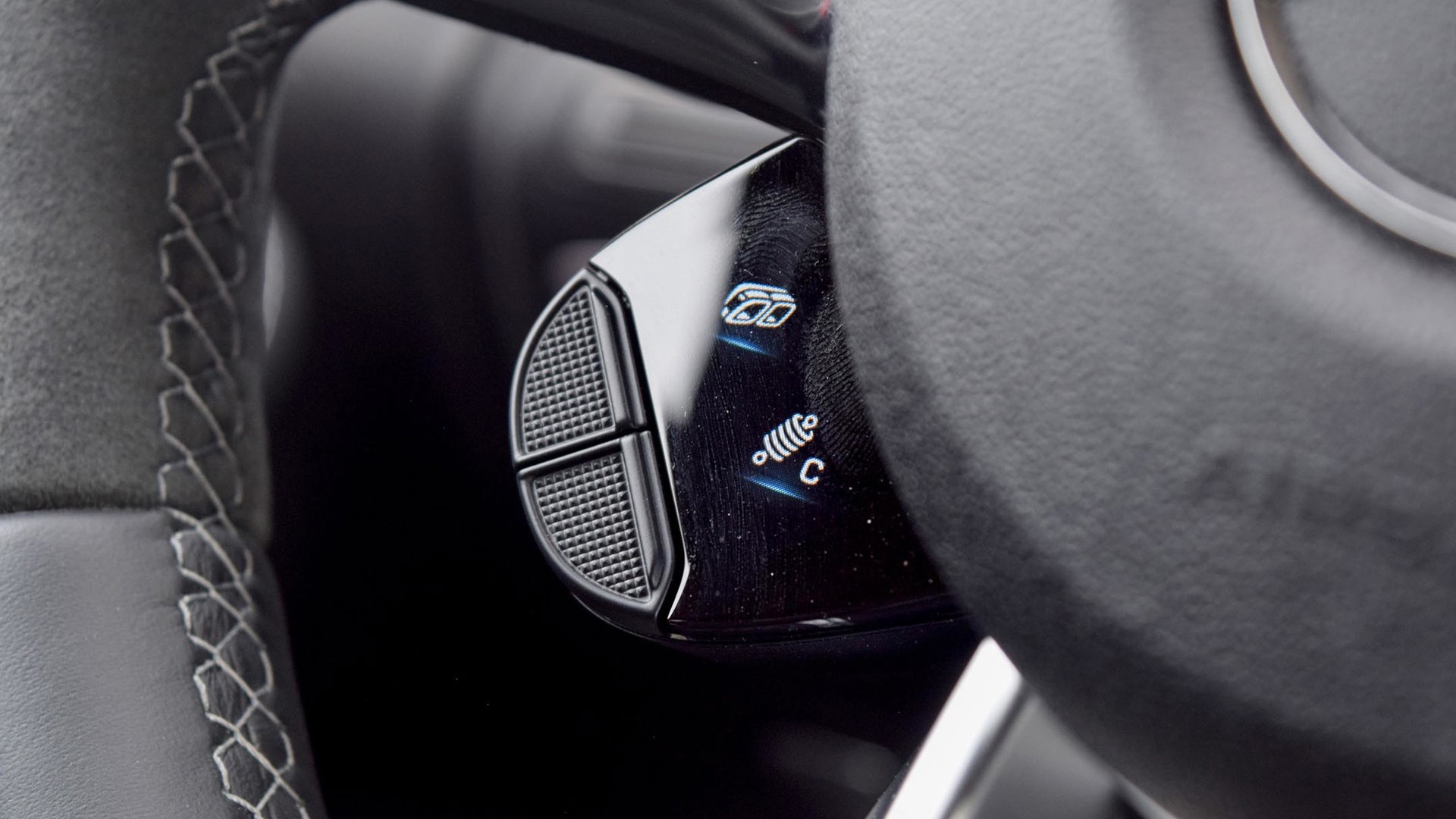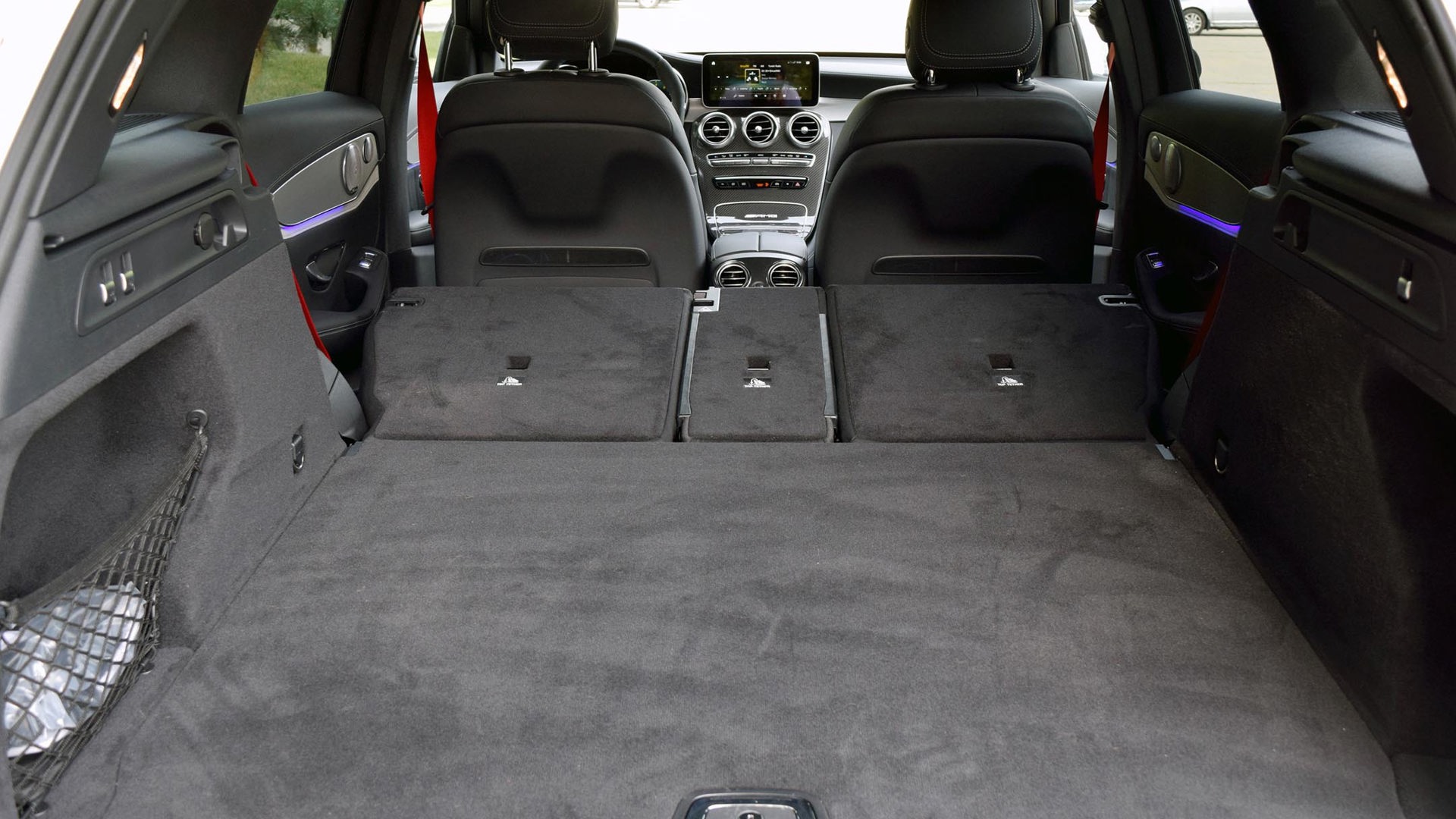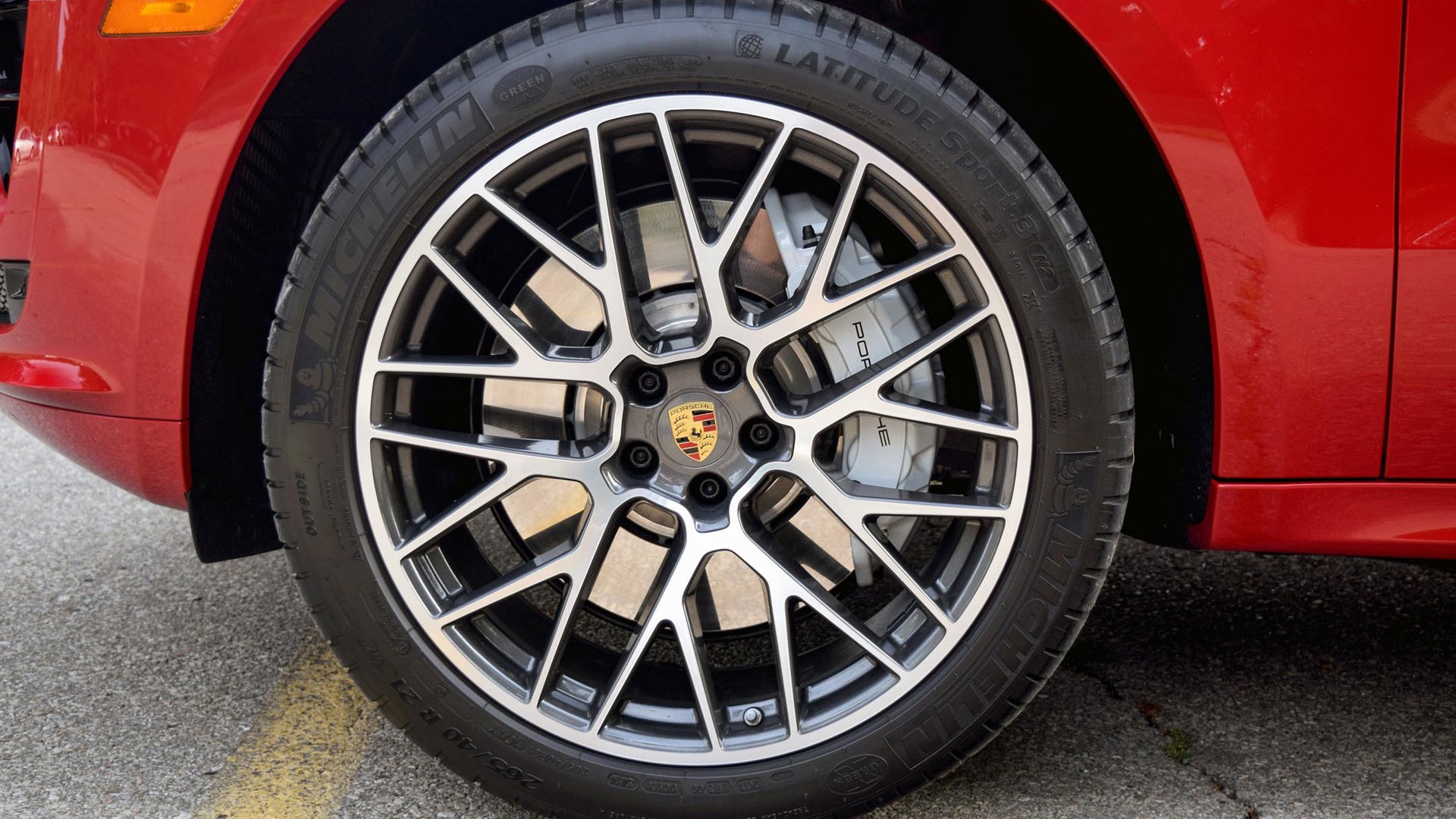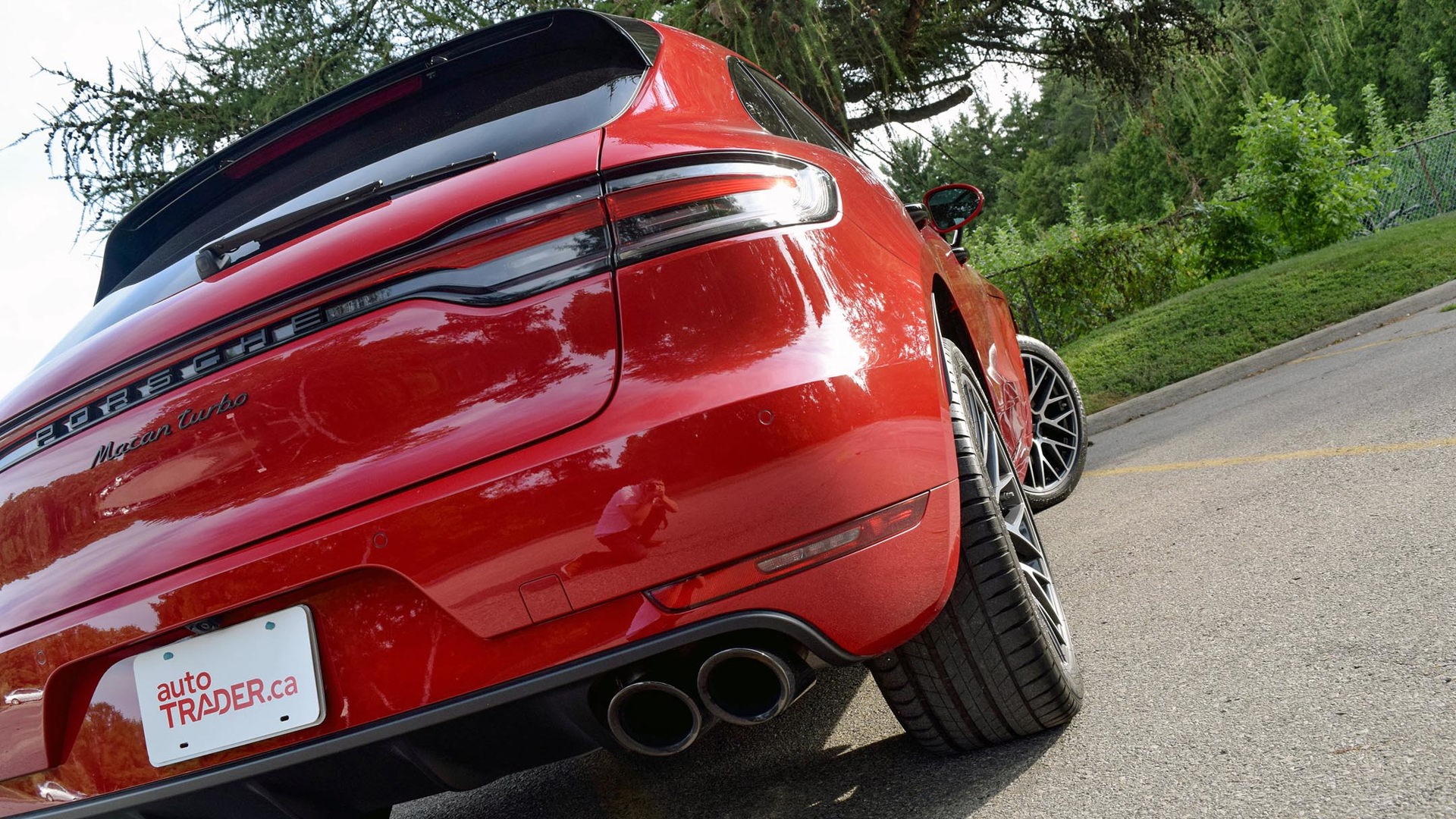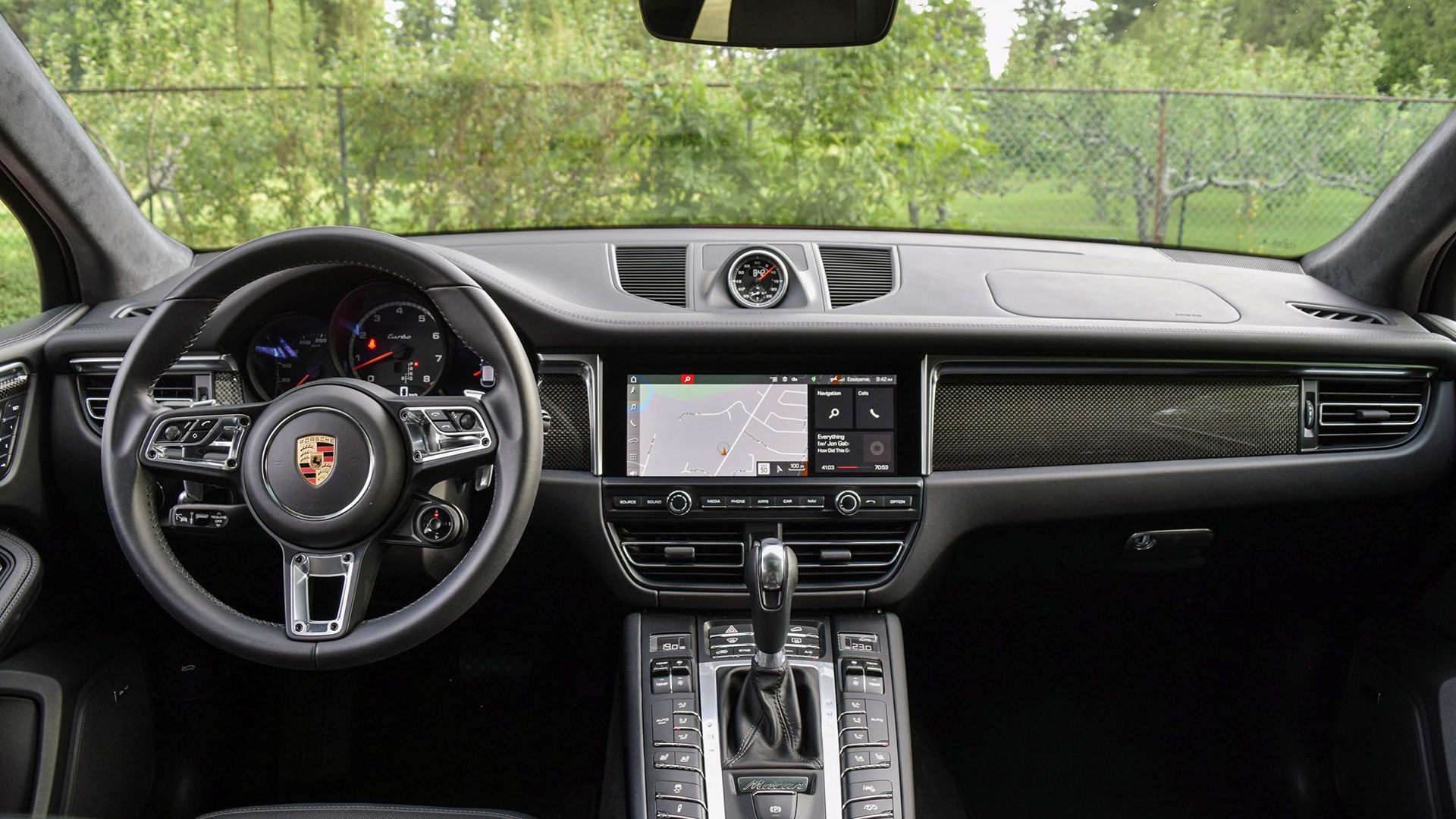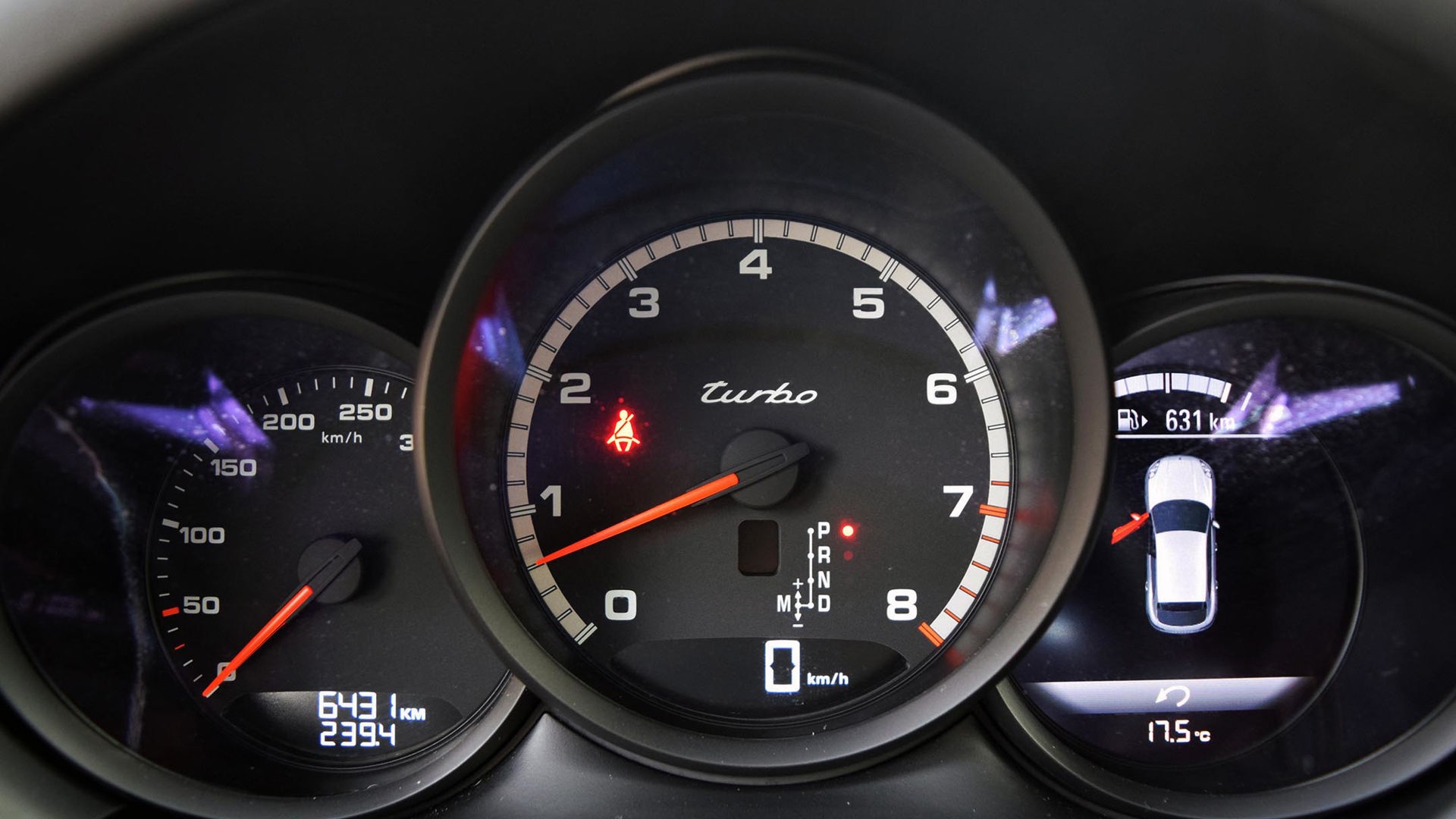Comparison Data
|
2020 Mercedes-AMG GLC 63 S
|
2020 Porsche Macan Turbo
|
|---|---|
|
Engine Displacement
4.0L
|
2.9L
|
|
Engine Cylinders
V8
|
V6
|
|
Peak Horsepower
503 hp
|
434 hp
|
|
Peak Torque
516 lb-ft
|
405 lb-ft
|
|
Fuel Economy
15.0 / 10.9 / 13.2 L/100 km cty/hwy/cmb
|
13.8 / 10.6 / 12.3 L/100 km cty/hwy/cmb
|
|
Cargo Space
550 / 1,600 L seats down
|
500 / 1,500 L seats down
|
|
Base Price
$93,000
|
$94,200
|
|
A/C Tax
$100
|
$100
|
|
Destination Fee
n/a
|
$1,500
|
|
Price as Tested
$112,350
|
$119,260
|
|
Optional Equipment
$19,350 – Red seatbelts, $250; AMG Drivers Package, $3,300; Intelligent Drive Package, $2,700; Premium Package , $6,200; Technology Package, $1,900; AMG Cabon Fibre Package, $1,500; Trailer Hitch, $800; Head Up display, $1,500; Climate Comfort Front Seats, $1,200
|
$23,560 – Carmine Red, $3,560; Full Leather Interior in Black, $2,150; Heated Multifunction GT Steering Wheel, $370; Roof rails in black, $460; Rear Sunshades, $340; 21 inch wheels, $1,900; heated rear seats, $600; heated windshield, $520; Carbon Fibre Interior Package , $1,080; Surround Camera View, $1,360; Tinted LED Headlights in Black, $1,190; Sport Chrono, $1,560; Adaptive Cruise Control, $1,330; Smart Phone Compartiment, $780; Extended Exterior Trim in Black, $1,730; Premium Plus Package, $4,630
|
Gaze into any suburban neighbourhood in Canada and you’ll likely find many of the same luxury crossovers. The compact Mercedes-Benz GLC-Class is a common sight, while the Porsche Macan is popular for its brand principles and sporty pedigree.
If you want a fun-to-drive GLC-Class, the 2020 Mercedes-AMG GLC 63 S packs a twin-turbocharged V8 and tons of personality. Over at Porsche, the 2020 Macan Turbo doesn’t make as much power but is up to the challenge.
Styling
Broadly speaking, crossovers can look similar across brands and segments, but these two vehicles put their own spin on the format. Each features cartoonishly large 21-inch wheels, which do quite a bit to minimize the frumpy design that most crossovers suffer from. For the Macan Turbo, the larger wheels are more effective at slimming the profile than the black bodyside cladding that’s usually found on the lower door panels of the Macan. That stripe is gone, but the crossover looks pretty trim by compact standards.
At the front of the Macan you’ll find large and functional intake openings hiding huge intercoolers, while the rear of the vehicle is highlighted by the large block Porsche lettering and huge exhaust tips. As is Porsche’s custom, you have a large selection of customization options for the exterior, choosing specific paint for the callipers, different wheel caps, and more. Our tester featured black roof rails, a blacked-out spoiler, and an LED headlight system that evokes the same light signature as the iconic Porsche 911.
Hop inside this Macan and you may wonder where all the unique Turbo accents are. While the vehicle is fully loaded, it portrays an air of focus and functionality over anything flashy. You can see this with the tach-centric gauge cluster, and the tiny infotainment screen. A huge bank of identical-looking buttons labelled in small font gives off a pretty confounding first impression, while the carbon-fibre interior accents are used sparingly.
Conversely, there’s something about the Mercedes-AMG GLC 63 S that just feels imposing. A large grille and wide fenders help the crossover look big, while Mercedes opts to slim its profile with the same blacked-out stripe that Porsche chose to omit. The multi-spoked wheels look like a headache to clean, but once in motion look incredibly slick, like they’re popping off the rims.
Inside the GLC you’re greeted with the usual suspects of luxury vehicle interiors. There is two-tone leather upholstery, shiny aluminum-trimmed controls, a generous amount of carbon-fibre accents, and screens everywhere. Even the drive-mode-select knob on the steering wheel has a little screen in it. There’s only one word to describe all of it: fancy.
Porsche Macan Turbo Styling: 7/10
Mercedes-AMG GLC 63 S Styling: 8.5/10
Safety
Unfortunately for consumers, the Insurance Institute for Highway Safety (IIHS) doesn’t have anything important to say about these two vehicles. The Macan hasn’t even been tested by the institute; while the Mercedes has been crash-tested, it failed to receive a Top Safety Pick rating. However, both offer a long list of features to keep you safe on the road.
In the Macan you can get adaptive cruise control, lane-keep assistance, lane-change assistance, and a great surround-view camera array. I found the adaptive cruise control to work well, even in stop-and-go traffic, and the parking sensors to be excellent at helping place the crossover in tight spots.
The GLC has a similar suite of safety features. Like the Macan, it has adaptive cruise control, lane-keeping assistance, and plenty of cameras for parking, but it also boasts a driver attention warning system, a crosswind assistance feature, and even an evasive steering assistance system for when the vehicle detects a potential collision and helps steer away from it. Both crossovers also have incredible LED lights and won’t have you squinting to read road signs or routes at night.
Porsche Macan Turbo Safety: 8/10
Mercedes-AMG GLC 63 S Safety: 8.5/10
Features
The list of features found on luxury crossovers with price tags over $100,000 is never-ending. Of course, both of these have features like heated and ventilated seats, heated steering wheels, massive sunroofs, wireless phone charging, power-adjustable memory seats, and power tailgates. But heck, even well-equipped subcompacts from Hyundai and Kia have those kinds of features, so what are we really looking for here?
We’re on the hunt for PEDs – performance enhancing doodads. These are speedy crossovers with burly engines, and that performance needs to be accessible to the drivers. More than that, these need the personality to go with that excitement. Cars this expensive should feel special, especially as they are twice the price of the standard models they’re based on.
Here are some of the PEDs found in both of these vehicles: launch control, adjustable traction and stability settings, customizable drive modes, and adjustable exhaust settings. Now that’s what I’m talking about! These features are everything when you’re trying to shed the mundane image of the normal models found throughout suburbia.
In the Mercedes you’ll find an air suspension system that can lower the vehicle for better stability at speed. It can also be lowered to make loading cargo easier. There’s also an available app that can track and store performance data when it’s time to hit the track. (We should also mention the other non-performance frills like 64-colour LED ambient lighting and the five USB-C charging ports found throughout the cabin.)
The Macan offers air suspension as optional equipment as well as carbon-ceramic brakes, but this Turbo model has improved brakes over lesser Macan models that have serious stopping power. Both vehicles feature drive-mode selectors on their steering wheels, but the Porsche knob has a central button that turns every adjustable feature to their most aggressive setting for maximum performance. This trim also features a few USB-C ports for charging devices and a heated windshield.
Porsche Macan Turbo Features: 8/10
Mercedes-AMG GLC 63 S Features: 8.5/10
User Friendliness
Unless you’re used to the interior design of previous Porsches, it’s easy to get overwhelmed by the vast array of buttons inside the Macan. However, once you’re familiar with them they’re easy to access without taking your eyes off the road. This conventional switchgear is a bit more intuitive than the touch-only setup found in newer Porsches, but only just.
The infotainment system is a bit on the small side, and unfortunately, Porsche doesn’t offer Android Auto compatibility with its system, though there is Apple CarPlay support. Ensure you have a USB-C cable, though, since those are the only ports in the vehicle. While the steering wheel is loaded with controls, the great-feeling paddle shifters are clustered too closely to some control stalks, making them a bit tough to slap during enthusiastic driving.
The GLC has bigger paddles that can be reached without interference from the stalks, and the cabin feels a bit cleaner overall in terms of control – although the steering wheel is very cluttered. The biggest downside here is the touchpad controllers for navigating the infotainment system and gauge cluster. There’s one large pad on the centre console and two smaller thumb pads on the steering wheel. The steering-wheel-mounted pads can be accidentally triggered at times, causing the gauge cluster to change unexpectedly.
There’s also a drive-mode-selector knob on the wheel, as well as two additional buttons that can be customized to adjust items like suspension, exhaust, or traction control. Add these buttons to the usual controls and rockers found on a steering wheel, and it may be a bit too much.
Fortunately, the main infotainment display can be operated via touch, and the GLC features Android Auto support in addition to Apple CarPlay compatibility. There’s also a helpful digital assistant that responds to “Hey Mercedes,” in case you prefer voice controls. I always love the addition of a head-up display, and the layout of the HVAC controls is nice and simple while looking elegant.
Porsche Macan Turbo User Friendliness: 7/10
Mercedes-AMG GLC 63 S User Friendliness: 7.5/10
Practicality
Instead of focusing purely on performance, Mercedes also takes care of the everyday usability of the vehicle. The air suspension helps to lower the vehicle when loading cargo, but there are also buttons in the cargo area for folding the rear seats. There’s 550 L of storage behind the rear seats, which expands to a healthy 1,600 L when those seats are folded. [The numbers don’t tell the whole story here, as the cargo area is bigger than the specs would suggest. – Ed.] The rear seats are also more comfortable than those in the Macan, which lacks head- and legroom.
While the rear seats in the Macan fold, doing so has to be done from the rear seats and not the cargo area like the Mercedes. There’s about 500 L of storage behind the rear seats, and that reaches 1,500 L with the seats folded. The rear seats feel pretty claustrophobic, though there are HVAC controls and heated seats, as well as helpful rear sunshades. Porsche says the Macan Turbo can tow a max of 2,009 kg (4,430 lb), which is a good chunk more than the GLC’s max of 1,588 kg (3,500 lb).
Porsche Macan Turbo Practicality: 7/10
Mercedes-AMG GLC 63 S Practicality: 8/10
Comfort
Once you start driving the Macan Turbo you get a whiff of the 911 experience that Porsche tries to bake into each of its vehicles. That has a lot to do with the firm road feel and heavy steering at low speeds. It’s not painfully stiff, but you do notice the bumps and imperfections on the roads.
The seats aren’t especially soft and plush, but they are very supportive, holding you in place even as you slingshot through a corner at high speeds. Other amenities include the heated steering wheel – which is activated by a hidden button behind one of the spokes on the steering wheel – and ventilated front seats, which all worked nicely during testing. The vehicle is insulated from outside noise, just as you’d expect from a premium vehicle.
I have a tough time describing the sound-deadening in the GLC the same way. I can’t confidently tell you that there’s a lot of wind or tire noise since all you hear is the engine and exhaust – and honestly, that’s a far better experience than any droning wind anyway.
The seats are a bit softer than the Macan’s, which combines well with the more spacious cabin to provide a comfortable driving experience. The ride seems just as firm as the Macan’s, though the Mercedes has a slightly longer wheelbase, which helps it feel a bit less jittery on broken pavement.
Porsche Macan Turbo Comfort: 7.5/10
Mercedes-AMG GLC 63 S Comfort: 8/10
Power
The Macan packs a twin-turbocharged 2.9L V6 engine making 434 hp and 405 lb-ft of torque. This is paired to Porsche’s seven-speed dual-clutch automatic transmission – a mouthful of a unit known as the Porsche-Doppelkupplungsgetriebe, or PDK for short – and all-wheel drive.
The motor can be pretty gruff, particularly when firing off upshifts, with a metallic buzzsaw sound effect as the car blasts into the next gear. The sprint from a standstill to highway speeds takes just over four seconds, which is blazingly quick. However, it’s important to note that in typical driving situations the Macan feels rather sedate as the transmission seems reluctant to downshift at times. The remedy to this is to put the car in its sportiest settings or take control of the transmission manually via the paddle or gear selector. I’ll admit the contrast in powertrain dynamics between the modes is nice to have, as sometimes you just want to take the car to the store and don’t need it to be in the most aggressive, loud, head-turning mode.
The Mercedes-AMG GLC 63 S is different in this regard. It uses a twin-turbo 4.0L V8 engine that puts out 503 hp and 516 lb-ft of torque. There’s a nine-speed multi-clutch transmission here that feels a touch slower than Porsche’s refined PDK, and Mercedes loves to boast about its all-wheel drive system that can send 100 per cent of the available power to the rear wheels.
Let all that power loose and the GLC will hit 100 km/h in 3.8 seconds, which makes this one of the fastest crossovers around. You can close any distance with ease, and the powertrain is eager to drop a gear and give you more velocity whenever you want it, regardless of the drive mode you’re in. Beyond the speed and power is the sound of this V8, which is simply intoxicating. Every push and prod of the throttle results in noises that will make you smile or laugh, especially when you consider that you’re driving an icon of suburbia – the compact luxury crossover.
Porsche Macan Turbo Power: 8.5/10
Mercedes-AMG GLC 63 S Power: 9.5/10
Driving Feel
All that speed needs to be paired to an engaging chassis and ride. The Macan feels so responsive and agile, proving there is some truth to Porsche’s claim that there’s a bit of 911 in each of the brand’s vehicles. The steering is weighty and precise at low speeds but gets a bit lighter at higher speeds, which helps with that agility – though it can lead to some less-than-confidence-inspiring handling. However, thanks to the impressive brakes, the Macan gets back to your comfort zone and is ready to comply with your commands. While the ride is firm, the good news is that there is very limited body roll when cornering.
The GLC is a little less precise than the Macan in almost every condition. There’s lighter steering at lower speeds, which can feel a bit sloppy, though it gets nice and heavy at higher speeds. The brakes are strong but need more pedal travel to get things slowed down. And there is more body roll in the corners with this GLC. That’s where the well-bolstered seats come in handy. While the GLC is lighter than the Macan Turbo, it never really feels like it. More often than not, the Mercedes feels much larger and more substantial than the Porsche, which adds a bit of confidence on the road at the cost of some of the fun you might be expecting.
Porsche Macan Turbo Driving Feel: 8.5/10
Mercedes-AMG GLC 63 S Driving Feel: 8/10
Fuel Economy
With that much performance, you shouldn’t be surprised to hear that both of these crossovers aren’t particularly great at the pump. The Macan Turbo is only slightly worse than its non-Turbo iterations, returning 13.8 L/100 km in the city, 10.6 on the highway, and 12.3 combined.
Mercedes lays the burden of its two extra cylinders on your wallet. Expect it to deliver 15 L/100 km in the city, 10.9 on the highway, and 13.2 combined.
Porsche Macan Turbo Fuel Economy: 6/10
Mercedes-AMG GLC 63 S Fuel Economy: 5/10
Value
Value probably isn’t a real consideration with vehicles like these – at least not in the traditional sense. A base Macan or GLC will cost somewhere around $50,000 each, but these models arrived with price tags that were more than double that. While the Macan Turbo starts at $94,200, my tester came with plenty of options, including the extra cost Carmine Red paint ($3,560), the Premium Plus package ($4,630), a full leather interior ($2,150), a heated steering wheel ($370), blacked-out roof rails ($460), the 21-inch wheels ($1,900), and the Sport Chrono package ($1,560), just to name a few. When you reach the bottom of the list of features in this Macan Turbo, the tally is up to $119,260 although that includes $1,500 in fees.
The Mercedes isn’t much better. It starts at $93,000 and includes several extra packages including the $6,200 Premium package, and the $1,900 Technology package. The few other options included add up to a price tag of $112,350 before any other fees. Value in these crossovers? That’s tough to rationalize if you’re looking for anything other than speed.
Porsche Macan Turbo Value: 5/10
Mercedes-AMG GLC 63 S Value: 6/10
The Verdict
These two crossovers are full of power and speed. They’re also a far cry from their mundane and more mainstream counterparts. The Macan Turbo channels its Porsche charm successfully with an agile feel on the road, but that comes with a few downsides, too, especially in terms of interior space and ergonomics. A next-generation model is expected soon, and we wouldn’t be surprised to see our complaints addressed promptly.
The Mercedes-AMG GLC 63 S feels more modern, with a premium and tech-filled cabin. It’s also rowdier and attention-grabbing thanks to that incredible sounding and powerful V8 engine. After every stop in the action, it’s the one we couldn’t wait to get back into.





















